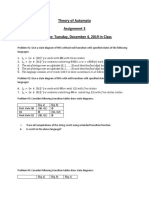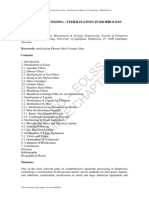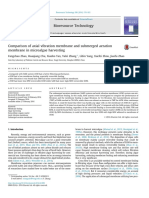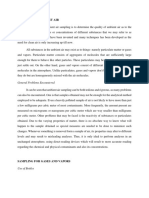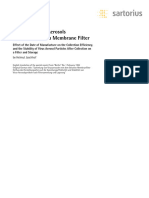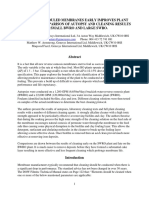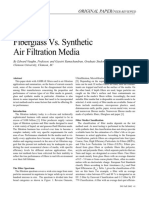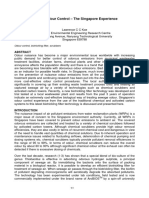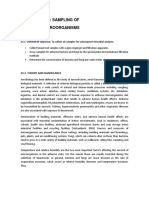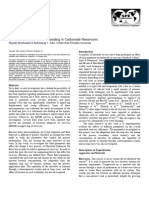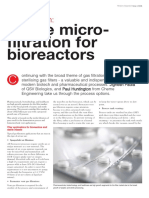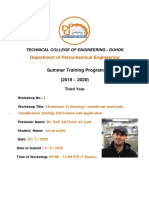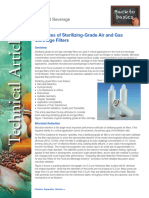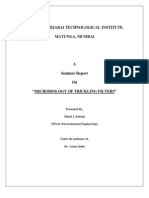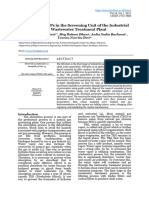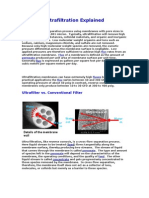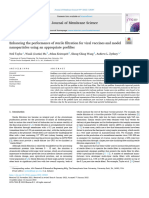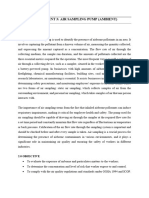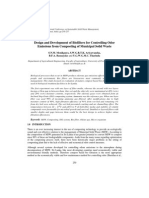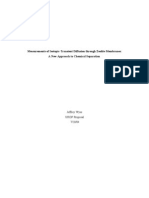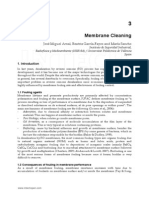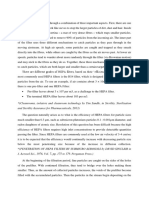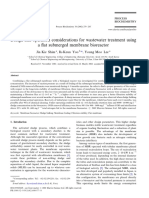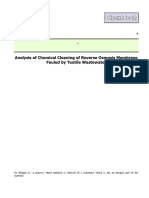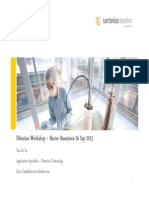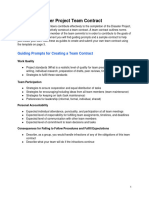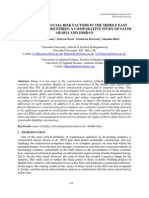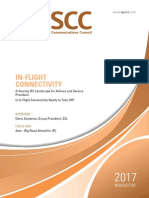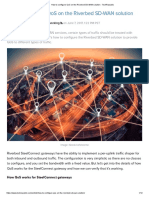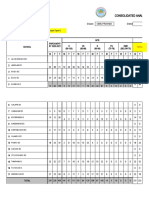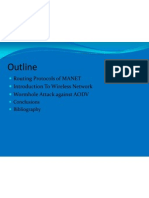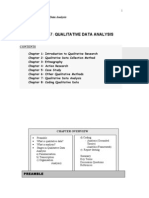Sterile Filtration of Gases by Membrane Filters: Timothy J. Leahy and Raymond Gabler
Sterile Filtration of Gases by Membrane Filters: Timothy J. Leahy and Raymond Gabler
Uploaded by
MaheshCopyright:
Available Formats
Sterile Filtration of Gases by Membrane Filters: Timothy J. Leahy and Raymond Gabler
Sterile Filtration of Gases by Membrane Filters: Timothy J. Leahy and Raymond Gabler
Uploaded by
MaheshOriginal Description:
Original Title
Copyright
Available Formats
Share this document
Did you find this document useful?
Is this content inappropriate?
Copyright:
Available Formats
Sterile Filtration of Gases by Membrane Filters: Timothy J. Leahy and Raymond Gabler
Sterile Filtration of Gases by Membrane Filters: Timothy J. Leahy and Raymond Gabler
Uploaded by
MaheshCopyright:
Available Formats
Sterile Filtration of Gases by
Membrane Filters
Timothy J. Leahy and Raymond Gabler
Corpora tion, Bedford, Massachusetts 01 730
Biotechnology Division, ~ i i l i p o r e
Accepted for Publication July 19, 1983
INTRODUCTION the fermentation takes place. In the case of some antibi-
otic fermentations, this can be for several days. Continu-
Sterilization by filtration is widely used to render fluids
ous culture techniques may require sterile air processed
free of microorganisms. Currently, membrane filters are
through the same filter for weeks at a time. Thus, gas
commonly used to sterilize heat-labile liquids, and their
filtration tends to be a long-term filter application. Also,
performance in this application has been studied exten-
gas filters are commonly used several times before dis-
sively. With the introduction of suitable membrane mate-
carding. For example, air filters to a fermentor may be
rial and filter fabrication, membrane filters are also re-
changed but once yearly. Thus, assuming weekly use,
ceiving increased attention for the sterilization of gases.
such filters would be sterilized on the order of 50 times
Examples of such applications include sterile tank vents
before their replacement. The principle reason why it is
and fermentor feed air. This article reviews the literature
possible to use an air filter element over and over is that
on gas filtration by membrane filters and highlights the
they tend not to get clogged as quickly as liquid filters.
microbiological aspects of sterile gas filtration. In addi-
This is primarily due to the relative particle loads of the
tion, a method for testing the microbial retention charac-
two fluids.
teristics of filters in gas filtration is described.
This article addresses the problem of microbial removal
It is convenient to classify sterile filtration processes by
in gas filtration and specifically looks at membrane filters
the type of fluid being processed. For example, fluids are
in this application.
generally classified as being either gases or liquids. The
general type of fluid being processed is important since
this affects many of the characteristics of the filtration pro-
LITERATURE OVERVIEW
cess. The principle importance in the comparison of liquid
to gas filtration lies in the microbial retention properties Some of the earliest studies on microbial removal in
afforded by filters in each. In some respects, the sterile fil- gases were done on fiberglass (nonmembrane) filters. For
tration of liquids is more difficult than gases. Gas filtra- example, Maxon and Gadon’ studied the efficiency of
tion, however, has its own problems with respect to sterile bacterial spore removal by a prototype air filter for use in
filtration. The difficulties in liquid sterile filtration are due fermentation. The filter was made from resin bonded
to the properties of the fluid, which encourages organism glass fiber mats which were stacked within a metal tube.
passage, and the numbers and types of microorganisms Suspensions of spores were aerosolized and the contami-
associated with the fluid. Gas filtration poses problems be- nated air stream was fed to the filter. The extent of spore
cause of the length of the filtration process and the poten- penetration within the filter was determined by removing
tial for damage upon repeated use of the filter element. sections of the filter mats, and counts of organisms were
Typically, liquid sterile filtration is a short-term opera- determined at various depths. Characteristic of depth type
tion dealing with batch sizes requiring on the order of filter media, spores were found to penetrate within the fil-
eight hours or less filtration. The filter element is steril- ter structure, the extent of which was a function of air ve-
ized, liquid is pumped through a filter for a few hours, and locity. Penetration was also affected by moisture: wet fil-
the filter element is discarded. Seldom in liquid filtration ters showed more penetration. The key point of this article
is the filter resterilized and used to process another batch. was the observation of spore penetration deep within the
The filter becomes partially clogged during liquid filtra- filter, a property characteristic of depth filters.
tion, precluding economic use after one batch. Also, gov- One of the first reports of particle removal by mem-
ernmental regulations often limit filters to a single use. brane filters in air was published by Megaw and Wiffen.
In contrast, gas filtration tends towards continuous In a study using inanimate particles, they found that rela-
operation. For example, vent filters on tanks would stay in tively large pore size filters were highly efficient at remov-
operation as long as the tank is in use. Also, air to a fer- ing particles about two orders of magnitude smaller than
mentor is continually sterilized by filtration for as long as the pore size. They concluded that this high efficiency was
Biotechnology and Bioengineering, Vol. XXVI, Pp. 836-843 (1984)
0 1984 John Wiley &Sons, Inc. CCC 0006-35921841080836-08504.00
due to diffusion (Brownian motion) of the particles to the hydrophobic membrane filter cartridges. They were dis-
surface of the filter and not electrostatic attraction. These satisfied with fiberglass as a filtration medium because:
results of efficient particle capture by relatively large- 1) it was a depth-type filter which gave inconsistant and
pore-size membrane filters highlight the enhanced re- unpredictable microbial removal;
moval characteristics in air filtration. Equivalent-pore- 2) it was hydrophilic and, therefore, could wet with
size filters challenged with particles (bacteria) a factor of water from their compressed air lines and restrict air flow;
ten larger than those used by Megaw and Wiffen in liquid and
tests show capture efficiencies orders of magnitude 3) it was difficult to handle and labor intensive to
lower. replace.
The results of Megaw and Wiffen have been recently In the evaluation process for upgrading their air filtra-
substantiated by R ~ b o w .Sodium
~ chloride aerosols of tion system, Bruno and Szabo found that the contamina-
various particle sues were generated in this study using fil- tion rate of the germinator tanks was reduced by 78.3%.
tered compressed air (85 psi) and an atomizer with NaCl After a six-month evaluation on a contamination-prone
solutions ranging in concentration from 0.001 to 10%. production fermentor, the rate of contamination was 50%
The liquid droplets were then dried by passage through a lower with membrane cartridges than with a control using
diffusion drier, and any charges were neutralized by a packed glass wool. In light of these results, they converted
radioactive krypton-% source. This concentrated aerosol their germinator tanks to membrane cartridges and in-
stream was then mixed with a clean air stream to produce tended to convert their production fermentors to car-
the aerosol challenge. Particle concentrations both up- tridges as well.
stream and downstream of the test filter were measured It is clear from reports in the literature that each test
with a condensation nucleus counter capable of detecting method has strengths and weaknesses. For example, us-
particles 0.02-1.0 pm in size. Under all test conditions, ing well-characterized test organisms (living particles) at
the penetration of the NaCl aerosol challenge through a known concentrations helps standardize the evaluation of
0.2-pm-pore-size membrane filter was undetectable. The filter performance. Short test times, however, do not re-
removal efficiency of 0.05-pm particles was greater than flect the actual conditions of air filtration. On the other
1Olo at low flow rates (AP = 5 psi). The removal efficiency hand, approaches which test filters for extended time
at higher flow rates always exceeded lo8. periods often lack the knowledge of how many and what
Duberstein and Howard5 published a method of testing type of microorganisms are challenging a filter. Thus, we
gas filters using bacterial cells as the challenging particle. have attempted to develop an improved test method which
A suspension of Pseudomonas diminuta was aerosolized combines the features of standardized microbial chal-
and impinged onto the surface of a filter for six minutes. lenge and long-term testing under operating conditions
Air downstream of the filter was assayed by an Anderson simulating air filtration in practice.
six-stage sampler which collected cells onto the surface of One approach to developing a test procedure is to con-
a Petri dish filled with a bacterial growth medium. A posi- sider the failure modes that would compromise the perfor-
tive feature of the Duberstein and Howard test is that a mance of an air filter. Air filters could allow the passage of
controlled high level of a well-characterized organism was microorganisms in the following ways: 1) passage through
used to challenge a filter. A major shortcoming was the the filter medium, 2) passage through a defect, and 3)
brief duration of the challenge. Also, the size-separating growthrough. A good air filter test would expose the filter
impinger seems unnecessarily complicated, and no efforts to the possibility of failure by any or all of these modes.
were made to control the humidity of the air stream, which Passage through the filter medium or through defects can
may have affected the viability of the challenge organism. be challenged by using large numbers of small organisms
Olson, Houton, and Ellis6 developed a long-term air fil- dispensed as some kind of aerosol. Growthrough, a more
ter test. It used ambient air as the source of the microbial subtle consequence of a wetting filter medium which con-
challenge for a period of several days. A filter under test tains microorganisms, can be measured by a long-term
was placed on a carboy of sterile broth, and air was contin- test with liquid water present. Methods described in the
uously drawn through the filter via a vacuum port. Any or- next section address these failure modes.
ganisms passing through the filter were impinged in the
broth via a tube running to the broth surface from the air MATERIALS AND METHODS
filter. Filter failure was detected by visual inspection for
turbidity of the broth medium. This test is appealing in its Test Organisms
simplicity and does provide a long-term challenge, but the
nature and number of challenge organisms are unknown Pseudomonas diminuta ATCC 19146 was used as the
and uncontrolled. biological indicator of filter performance. A small, Gram-
Bruno and Szabo’ took a more pragmatic approach to negative rod, it has been widely employed by both users
testing the performance of air filters for fermentors. They and manufacturers to validate sterilizing filter performance
compared the rates of contamination occurring in both in liquids. It was grown in saline lactose broth to optimize
germinator tanks and production fermentors in a manu- its morphology for filter testing. Limited experimenta-
facturing facility when using either packed glass wool or tion on bacterial growthrough in liquid systems was also
LEAHY AND GABLER: FILTRATION BY MEMBRANE FILTERS 837
carried out with a lab stain of Escherichia coli in addition ued until either the filter plugged or the test organism ap-
to Pseudomonas diminuta. peared in the effluent. A similar approach was used to test
hydrophobic membrane filter cartridges. In this case, a
Test FiIters cartridge was placed in a modified cartridge holder and
sterilized. Sterile SCD broth was placed upstream and
The majority of the experiments were performed on
downstream of the filter, and the upstream was inoculated
commercially available hydrophobic membrane filter car-
with P. diminuta. The modified holder (Fig. 2) was placed
tridges (Millipore Corporation, Bedford, Massachusetts)
in a shaker incubator so that it would be agitated during
with a 0.22-pm pore size. The filter material was made
testing. Clear plastic viewing ports on the downstream side
from DuraporeO (polyvinylidene difluoride), an inherently
allowed inspection for turbidity during the test.
hydrophobic polymer related to Teflon. Experiments on
growthrough were performed with both hydrophobic car-
Extended Aerosol Challenge Test (EACT)
tridges and disks of hydrophilic membrane filters (mixed
esters of cellulose). A schematic of the EACT apparatus is shown in Figure 3.
In construction, it is similar to the apparatus (Fig. 2) that
Test Methods was used to test specifically for growthrough. Again, on
the downstream side, there is a see-through window that
Two test methods were developed. One was used essen-
allows for turbidity determinations. Directly upstream
tially to measure growthrough under liquid test conditions
from the viewing window is a liquid impinger that directs
and the other was an aerosol-based test run for extended
the air flow into SCD broth so any organisms passing
time periods.
through the test filter are deposited in an environment
that will favor their growth and detection.
Growthrough Test
The test procedure is as follows. Air is first humidified
Flat 47-mm disks of hydrophilic mixed esters of cellu- (100%) by being passed through a water bath (not
lose membrane filters in various pore sizes were tested for shown). This is to insure moist air so that test organisms
bacterial growthrough. Figure 1 shows the experimental do not dessicate and die. The air is then filtered through a
apparatus. Both pore size filters were challenged with sus- 0.22-pm filter. This is done to protect the purity of the
pensions of either P. diminuta or E. coli. At fixed time in- bacterial test suspension and to remove competing or-
tervals after the initial challenge (lo8 organisms/cm2 ganisms and particles that might complicate analysis later
filter area), sterile soybean casein digest (SCD) broth was on in the procedure. The air then passes through an
forced through the test filters, and the microbial content aerosol jet nozzle (shown in silhouette) which generates
of the effluent was analyzed. Experimentation was contin- the bacterial laden aerosol. The legs of the nozzle (model
URE
fi CARTRIDGE HOUSING
I 1 - UPSTREAM
M- FLUID
CHAMBER
TEST FILTER
- DOWN STREAM
PORT
DOWNSTREAM VIEWING
PORT
FLUID Figure 2. Schematic of test device used to measure growthrough of hy-
CHAMBER drophobic membrane filter cartridges.
CARTRIDGE HOUSING
AERSOL
NOZZEL. ,
HUMIDIFIED
AIR
CHALLENGE
RESERVOIR OWNSTREAM
VIEWING
PORT
Figure 1. Schematic of test device used to measure growthrough on Fipm 3. Schematic of the Extended Aerosol Challenge Test (EACT)
47-mm disks of hydrophilic membrane filters. device for the aerosol-based bacterial retention test method.
838 BIOTECHNOLOGY AND BIOENGINEERING, VOL. 26, AUGUST 1984
H1/2A, Beta Fog Nozzle, Greenfield, MA) drop vertically
into a suspension of P. diminuta that is contained in the
reservoir below. A total of ca. 800 mL suspension is con-
tained in the reservoir, and the concentration of the bac-
teria is ca. 107/mL. The bacteria-laden aerosol then
impinges onto the filter surface (7.5 ft2). The air will pene-
trate the filter, and some of the moisture will coalesce and
run down the filter and back into the bacterial suspension
reservoir. All air that passes through the filter is then
directed to the surface of the nutrient solution by the small
orifice (0.05 in.) of the impinger system. Air is then allowed
to exhaust through another filter which is placed in the
system to prevent back-contamination. The entire system
is under positive pressure, so contamination from the out-
side is minimized. The total test period is four days, dur-
ing which the aerosol generation is operated in a cyclic
manner. The air is turned on for 2.5 h continuously and is
then shut off for the next 9.5 h. This cycle is necessary so
as not to evaporate all the fluid in the bacterial test ngUre 4. Scanning electron micrograph of a 0.22-pm pore size
suspension reservoir and collection reservoir as a result of membrane filter in cross section challenged with lo8 P. diminuta
the pressure drops across the atomizer (AP = 10 psi) and ATCC19146/cm2 filter area. Area at top of micrograph shows the
the impinger (AP = 15 psi). These pressure drops allow deposition of bacterial cells at the surface of the filter.
the air to expand and increase its capacity to hold
moisture. Total bacterial challenge to the filter over the
entire test time is on the order of 1O1O organisms, and the much smaller than the effective pore size of the filter can
air flow rate is 1 SCFM at an inlet pressure of 25 psi. be removed because the particles “stick” or adhere to the
filter material itself. Figure 5 is an scanning electron
microphotograph (SEM) of a depth filter with no rated
RESULTS AND DISCUSSION
pore size, yet the filter is seen to sequester bacteria
(Pseudomonas diminuta) because of the attraction be-
Mechanisms of Filtration
tween the organisms and the filter material. It is quite ob-
There are basically two mechanisms that are responsible vious that some spaces between the fiber strands are much
for all types of filtration: adsorption and sieving. Sieving larger than the organisms; however, once the bacteria
is that process whereby a particle is denied access through touch the fibers, they tend to stick and are taken out of the
a pore or passageway which is smaller than the particle it-
self. Retention is simply a function of the particle being
bigger than the passageway. Sieving is purely a physical
mechanism of particulate or bacterial removal. The fact
that marbles cannot pass through a screen door mesh is an
elementary example of sieving. Sieving can occur at the
very upstream surface of a filter or at some internal part of
the filter matrix, depending on the type of filter that is be-
ing used. Figure 4 is a side view of a filter, illustrating the
complete retention of Pseudomonas diminuta microor-
ganisms on the top side of a 0.22-pm-pore-size membrane
filter. The maximum dimension of the organism shown in
Figure 4 is 0.3 pm. Membrane filters generally retain all
or most of the challenging bacteria on the surface of the
filter, whereas depth filters have to rely on their thickness
to retain particles. The filter in Figure 4 has been chal-
lenged by a suspension of bacteria with a concentration of
10s/cm2, so the entire filter surface was covered with a
monolayer. If the filter in Figure 4 had a pore size of 0.45
pm or larger, some organisms would have passed beyond
the surface and would have been found trapped within the
depth of the filter matrix. Adsorption, on the other hand,
is a mechanism that relies on the chemical interaction be- l%gun?5. Scanning electron micrograph of the surface of a glass fiber
tween the particle and the filter matrix. Particles that are depth filter challenged with P. dirninuta ATCC19146.
LEAHY AND GABLER: FILTRATION BY MEMBRANE FILTERS a39
fluid. Adsorptive mechanisms can occur throughout the by gravitational forces and be “pulled out” of the fluid
entire volume of the filter. Particle retention is not re- stream. In general, however, gravitational forces are very
stricted to the top surface, and adsorptive mechanisms de- weak compared to other types of forces that come into ac-
pend on the chemistry of interaction between the particles count here. For instance, if we were to calculate the force
and the filter. If the suspending fluid chemistry changes, of attraction between two particles due to gravitational
so too may the removal efficiency. Filters relying on ad- and Coulombic electrical forces, respectively, it would be
sorptive mechanisms for removal generally are con- found that gravitational forces are insignificant. As an ex-
structed with large surface areas. ample, consider two particles that are 1 pm apart in air,
In air filtration, the mechanism of sieving is just as each having a charge equal to one electron (but of opposite
strong and effective as it is in liquid filtration. Bacteria signs), and each a mass of lo7 daltons. For this example,
can still be removed by size exclusion. However, adsorp- the ratio of gravitational to electrical forces is roughly
tive mechanisms are much more powerful in air filtration loWm; the ratio is loW5if one of the particles has a mass of 1.
than they are with corresponding cases in liquid filtration. In both cases, gravitational forces are too small to be
This would seem to be an advantage for sterilizing air to a significant.
fermentor or for containing a pathogen or a recombinant Figure 7 illustrates the mechanism causing contact via
organism. diffusion. If a fluid stream is flowing along in a path that
To examine why adsorption in air filtration is more will come close to, but not directly in zontact with, part of
prevalent than in liquid filtration, it is necessary to ex- the filter matrix, a particle in that stream can move lat-
amine the modes of action that exist for bringing particles erally via diffusion and come into contact with the matrix.
or bacteria into contact with the filter material. There are The dotted line in Figure 7 schematically represents a
basically four such modes of action: impingement, sedi- possible spatial envelope around one flow line in which a
mentation, Brownian diffusion, and electrical forces. particle may be found at any point in time where the lower
Each of these modes will now be separately discussed, and most point contacts the filter material. Diffusion coeffi-
their relative characteristics and magnitudes compared cients of particles are a function of the density of the sus-
for filtration with water or air as the suspending medium. pending fluid; hence, for air, one would expect signifi-
Figure 6 illustrates impingement. The horizontal white cantly higher diffusion coefficients compared to water.
lines represent flow streams in a fluid, and the gray circles Again, there is a higher probability of contact between
are particles being carried along by that fluid. If a particle particle and filter via diffusion because the density of air is
has a large enough mass when the flow stream it is in so much less than that of water, and air will offer less resis-
passes through a blocking piece of filter material, the tance to movement. The smaller the particle, the larger
suspended particle will continue in its original direction, will be the diffusion coefficient and the higher the proba-
thus impacting the matrix. Newton’s first law of motion bility of contact between particle and filter matrix.
governs movement here, and unless there is enough force Electrical forces of attraction between particles and fil-
provided by the curving flow stream, the particle will not ter are conceivably the easiest to understand. Charges of
be able to pass through the obstruction. The force exerted opposite signs attract. Figure 8 is an SEM of a relatively
by the fluid stream on the particle is directly related to the large-pore-sizemembrane filter which has had its surface
density of the suspending medium, and air has a density chemically coated so that it is positively charged. When a
roughly lo00 times less than that of water, so it is not ex- solution of negatively charged latex particles is passed
pected that impingement mechanisms are stronger in air through the filter, mutual attraction causes the filter to
compared to corresponding cases in liquid filtration. In become coated with the latex, which would normally pass
general, impingement increases in relative importance as through the filter. The forces of electrical interaction,
the mass or size of the particle increases and as the velocity however, are reduced by the dielectric constant of the in-
of the flow stream increases. tervening medium between the particles. For water, the di-
Also illustrated in Figure 6 is sedimentation. A very
massive particle can be attracted to the filter matrix
iAML.IN€
$--
.
FlgoR 6. Schematic representation of particle transport during filtra- F I 7. Schematic representation of particle transport during filtra-
tion showing impingement and sedimentation. tion showing diffusion.
840 BIOTECHNOLOGY AND BIOENGINEERING, VOL. 26, AUGUST 1984
for bacteria and other microorganisms, because they have
one property that makes them unique from inert particles:
microorganisms are viable-they can reproduce and pos-
sibly grow through the filter. Under the conditions of use
for typical air filters, microorganisms are given an ideal
environment for growing. Once deposited on or in the fil-
ter, the long-term use of these filters and the presence of
water in the air stream will facilitate growth. The water
contained in the air can condense on the filter surface, not
only blocking the air flow, but presenting a growth
medium. If the filter is not inherently hydrophobic, but
has been chemically treated to be hydrophobic, water can
permeate into the pores as the treatment degrades, giving
the bacteria a growth path through the filter. Bacteria have
been known to grow and reproduce even in distilled water
sources seemingly devoid of nutrients. Growthrough,
then, is a potential mechanism which can lead to bacterial
passage in air filtration.
Experiments were first performed to determine the
effect of growthrough in liquid filtration with hydrophilic
F i i 8. Scanning electron micrograph of a positively charged mem-
filters. This work was done to act as a comparison for cor-
brane filter with negatively charged latex particles adsorbed to the surface. responding hydrophobic filter studies. For liquid grow-
through work, the effect of three variables was studied:
filter pore size, bacteria size, and bacterial doubling or
electric constant is 80 (at 20°C), whereas for air, it is ca. 1. generation time. P. diminuta was chosen as one test organ-
Therefore, if everything else is constant, straightforward ism because of its small size and general familiarity as a
Coulombic electrical forces in air are almost two orders of standard test organism for bacterial retention testing. E.
magnitude greater than a corresponding situation in coli was chosen as a test organism because it is somewhat
water. If the forces of attraction are due to dipole-dipole, larger in size than the P. diminuta, and because it has a
charge-induced dipole, or dipole-induced-dipole interac- relatively short generation time (20-30 min vs. over 2 h for
tions, then the electrical forces are reduced by the square P. diminuta).
of the dielectric constanL8 For these cases, the attractive The results of several liquid growthrough experiments
electrical forces would be more than 5000 times stronger are shown in Table I. As can be seen, growthrough did oc-
in air compared to water, assuming that bulk dielectric cur and it seems to be more prevalent for P. diminuta than
constants are used. Another factor that makes electrical forE. coli. For both the 0.22- and the 0.3-pm-pore-sizefil-
forces more potent in air compared to aqueous solutions ter, P. diminuta was detected first, long before E. coli was
relates to the counterions that usually surround a charged found in the downstream effluent. It took ca. five days
particle. In any real aqueous solution, every charged par- before growthrough occurred for P. diminuta with the
ticle has a cloud of counterions surrounding it, thus 0.22-pm filter. However, for the larger 0.3-pm filter, grow-
shielding the particle's charge and reducing the effective through occurred in one day. For both filters, it appears
strength of the original charge. This is not as true for air. that the size of the test organism was the dominant factor
Hence, a negatively charged bacteria in solution would in determining the speed of growthrough, with there being
have less of an attractive force to a positively charged filter little or no effect due to generation time. Therefore, pore
than for the comparable situation in air. size and organism size are, at least, two variables which
The theoretical conclusion is that filtering particles affect growthrough.
from air should be relatively easy compared to removing Clearly, growthrough is a complex phenomenon depen-
those same particles from an aqueous solution. Relatively dent on several other variables. Such things as the number
large pore-size filters, and even depth filters, should effi-
ciently remove small particles from air by one or more of
Table I. Growthrough results on a hydrophilic membrane filter with a
the above mechanisms. This is largely due to the proper- liquid challenge.
ties of gases versus liquids. A problem arises, however,
when one considers such living particles as micro- Filter pore size ( p n ) Organism Growthrough time ( h )
organisms and the dynamics of their growth.
0.22 P. dimin uta 2 120
E. coli >36Oa
Gro wthrough 0.30 P. diminuta 24
E. coli 180
Inert particles, once retained by a filter, usually remain
on, or attached to, that filter. This is not necessarily true aNo growthrough was detected prior to plugging.
LEAHY AND GABLER: FILTRATION BY MEMBRANE FILTERS 84 1
and type of organisms, the impact of the suspending liq- will also enhance growth conditions. Finally, the filter
uid on growth (inhibitory or stimulatory), and the dynam- elements should be stressed by multiple steamings and
ics of fluid flow could all affect the time for growthrough. autoclavings before being tested to assure the filter can
Under conditions which favored growthrough, such as stand up to the rigors of steriliiation and continue to be
high bacterial numbers in an environment which max- retentive.
imized growth, bacterial penetration took days to occur. Table I1 shows some typical operating results for the
Thus, under normal sterile filtrations of liquids which are EACT. The first significant results to note are those on the
limited to a few hours, growthrough will not compromise columns marked initial and final plate count. For the vari-
the filter's performance. ous experiments, these numbers quantitate the bacterial
It is useful to recall the observations of Maxon and population both before and after the experiments. These
Gaden' with depth filters. They clearly demonstrated results indicate that the viable bacterial count in the test
penetration of bacteria spores well within the depth of the reservoir remained relatively constant over the four-day
filter medium. If these were inanimate particles, and they period of the test. These figures confirm the result of other
did not penetrate all through the filter, a sterile effluent experiments (data not shown) that P. diminuta does not
would result. But, since these particles have the ability to dessicate and die if aerosolized in a moist air stream.
reproduce, especially if the filter is wet, then growthrough In all test cases, no organisms were detected down-
would thwart the adsorptive capture mechanism essential stream of the test filter, thus indicating complete reten-
in depth filters. Air filters, however, are usually hydro- tion. For one test, a small pinhole was artifically made in
phobic. Hydrophobic filters have an inherent advantage the filter with a needle. This was done to have an experi-
for preventing growthrough since water does not pene- ment that would serve as a check on the efficacy of the
trate their pores. If water is not present in the pores, then system as a positive control point. As the results show,
bacterial growth should be halted. For water to be intro- bacterial growth was observed on the downstream side of
duced into the pores of an inherently hydrophobic filter, it the filter (within 24 h). Finally, there is no difference in the
is necessary to overcome the intrusion pressure for the retentive capability of a filter, whether it had previously
filter. The intrusion pressure is, in some respects, op- been autoclaved once or stream sterilized in place ten
posite of the bubble point because it is the pressure needed times. The stressing associated with heat sterilization did
to force water into the pores of the filter. The intrusion not affect the filter's performance.
pressure is inversely related to the pore size of the filter Brock'O and Bruno and Szabo'have previously pointed
medium. In the case of a hydrophobic fibrous filter out several advantages that membrane filters offer over
medium, this is only a few psi. For 0.22-,urn-pore-size depth filters in air filtration. These include:
membrane filters made from hydrophobic polymers (e.g., (1) inherent hydrophobicity-efficient microbial re-
polyvinylidene fluoride), the intrusion pressure is ca. moval even in humid air streams and resistance to water
30-35 psi. Once the intrusion pressure is exceeded, water block age;
can freely pass through even the hydrophobic structure. (2) absolute retention of particles larger than the pore
The hypothesis that filter hydrophobicity will inhibit size;
growthrough was tested on hydrophobic filter cartridges. (3) retention performance, independent of fluid dy-
Results indicated that no growthrough was observed in ex- namics (AP,flow rate, hydraulic shock);
periments carried out for 21 days. This is in contrast to ex- (4) nonfiber releasing;
periments performed with hydrophilic membranes of (5) membrane structure precluding channeling; and
equivalent pore sizes where five days were required for (6) good track record in actual operation.
growthrough. Thus, filter hydrophobicity and resistance to We would add the resistance to growthrough as an addi-
water intrusion will effectively inhibit growthrough. tional advantage. Also, the high capture efficiency of small
particles in air streams by membrane filter^^,^ argues for
Extended Aerosol Challenge Test (EACT)
Table II. Extended aerosol challenge test results.
The EACT conditions described for growthrough studies
are abstract compared to the typical conditions of air fil- Upstream plate count
tration. Thus, we concurrently developed a complimen- (Organisms x I O ' / ~ L )
tary test method to reflect, as close as was practical, the Cartridge Do\*nLtream
actual operating conditions in air filtration. A number of sterilization Initial Final results
key features need to be incorporated in a test design. First,
Autoclaved (1 X ) 3.2 14 0
the test should challenge the filter with an aerosol contain- Autoclaved ( 1 X ) 7.1 42 0
ing a large number of bacteria and for a long period of Autoclaved (1 X ) 0.12 0.67 0
time. This not only simulates real-use conditions, but Autoclaved (1X )
maximizes the possibility of detecting a failure by any and Punctured 18 37 turbid ( + )
In-line steam (10 X ) 6.4 8.2 0
mode, whether it be a defect of construction, an oversized
In-line steam (lox) 4.8 9.2 0
pore or pinhole, or growthrough. Next, liquid water In-line steam (10 X ) 34 18 0
should be present because, again, this reflects reality and
842 BIOTECHNOLOGY AND BIOENGINEERING, VOL. 26, AUGUST 1984
the retention of virus particles to high levels of efficiency. polymers provide ideal media for air filtration, and the
In this case, the capture of potentially contaminating test methods described here help validate their perfor-
viruses within the depth of a membrane does not pose the mance.
same problems as would a free living microorganism
which could grow through the filter. Viruses need other
References
living cells to reproduce and without the appropriate host,
they cannot multiply. In other words, a virus becomes, es- 1. M. D. Maxon and E. L. Gaden, Ind. Eng. Chem., 48,2177 (1956).
sentially, an inanimate particle when removed by filtration. 2. W. J. Megaw and R. D . Wiffen, Int. J. Air Water Pollut., 7 , 501
(1963).
In summary, the typical operating conditions of an air
3. T. J. Leahy and M. J. Sullivan, Pharm. Tech., 2,65 (1978).
filter include extended filtration times where liquid water 4. K. L. Rubow, “Submicron Aerosol Filtration Characteristics of
may be present. Air filters are steam-sterilized and reused Membrane Filters,” Ph.D. thesis, University of Minnesota, Min-
many times before discarding. Air filters can fail by direct neapolis, MN, 1981.
passage of microorganisms through the filter medium or 5. R. Duberstein and G. Howard, J. Parent. Drug Assoc., 32, 192
( 1978).
by growthrough. Filter hydrophobicity is a key character-
6. W. P. Olson, L. Vanden Houten, and J. E. Ellis, J. Parent. Sci.
istic to both prevent air flow blockage by water and to in- Technot., 35,70 (1981).
hibit growthrough. Hydrophobicity is best maintained by 7. C . F. Bruno and L. A. Szabo, paper presented at the ACS Annual
using filter media which is inherently hydrophobic and re- Meeting, Division of Microbial Biochemistry Technical Sym-
sistant to water intrusion by having a small pore size. In posium, New York, NY, 1981.
8. R. Gabler, Electrical Interactions in Molecular Biophysics (Aca-
addition, a pore size on the order of bacterial cell size pre-
demic, New York, 1978), p. 182.
vents extensive penetration within the filter when sieving 9. M. S. Favaro, Science, 173, 173 (1971).
becomes the operating removal mechanism. Membrane 10. T. D. Brock, Membrane Filtration: A User’s Guide and Reference
filters with pore sizes of 0.22 pm made from hydrophobic Manual (Science Tech, Madison, WI, 1983), pp. 310-337.
LEAHY AND GABLER: FILTRATION BY MEMBRANE FILTERS 843
You might also like
- Teamwork and Team BuildingDocument25 pagesTeamwork and Team Buildingalizman100% (2)
- Assignment 3Document3 pagesAssignment 3Ali HamzaNo ratings yet
- Khelo IndiaDocument11 pagesKhelo IndiaMayank Tolani70% (10)
- Proposal - Hotel Keerthi PDFDocument6 pagesProposal - Hotel Keerthi PDFdeepakNo ratings yet
- Safe Use of Microbubbles For Removal of Ro Membrane FoulingDocument18 pagesSafe Use of Microbubbles For Removal of Ro Membrane Foulingashraf refaatNo ratings yet
- Upstream Processing - Sterilization in Bioprocess TechnologyDocument9 pagesUpstream Processing - Sterilization in Bioprocess TechnologyMark BangzNo ratings yet
- J Seppur 2021 118710Document13 pagesJ Seppur 2021 118710Hossein MalekmohammadiNo ratings yet
- Sampling InstrumentsDocument20 pagesSampling InstrumentserparixitpandeyNo ratings yet
- Zhao 2016Document6 pagesZhao 2016S TNo ratings yet
- Sampling of Ambient Air: General Problems EncounteredDocument10 pagesSampling of Ambient Air: General Problems EncounteredJulius ChavezNo ratings yet
- Filter Life Comparison of Different Levels of Nanofiber Coated Cleanable-Surface Filter For Gas Tribunes - Akduman2021Document17 pagesFilter Life Comparison of Different Levels of Nanofiber Coated Cleanable-Surface Filter For Gas Tribunes - Akduman2021aaroh420No ratings yet
- 1 PBDocument7 pages1 PBanandhra2010No ratings yet
- Sampling-Virus-Aerosols-Using-the-Gelatin-Membrane-FilterDocument4 pagesSampling-Virus-Aerosols-Using-the-Gelatin-Membrane-FilterlsisniegasNo ratings yet
- Cleaning Biofouled Membranes EarlyDocument11 pagesCleaning Biofouled Membranes EarlyNaim HossainNo ratings yet
- Biological Nutrient Removal in Bardenpho Process: Journal of American Science December 2014Document10 pagesBiological Nutrient Removal in Bardenpho Process: Journal of American Science December 2014Putry1No ratings yet
- El ShafaiZahidfullpaper Wwpr2012Document11 pagesEl ShafaiZahidfullpaper Wwpr2012vivian dimaandalNo ratings yet
- Fiberglass Vs Synthetic Air Filtration MediaDocument13 pagesFiberglass Vs Synthetic Air Filtration MediaSridhar VA100% (1)
- Basic Filtration ConceptsDocument3 pagesBasic Filtration ConceptsAFLAC ............No ratings yet
- Usp 1229.4Document11 pagesUsp 1229.4Rangga120890No ratings yet
- Waste Gas Treatment in BiofiltersDocument7 pagesWaste Gas Treatment in Biofilterssheladiyachintan13No ratings yet
- Sewage Odour Control - The Singapore ExperienceDocument8 pagesSewage Odour Control - The Singapore ExperienceNathanNo ratings yet
- Journal of The Air & Waste Management AssociationDocument12 pagesJournal of The Air & Waste Management AssociationIliana GarcíaNo ratings yet
- Filters and Filtration: A A A A ADocument6 pagesFilters and Filtration: A A A A ASyamsul IrmaNo ratings yet
- Aero BiologyDocument8 pagesAero BiologyFlavio ChipanaNo ratings yet
- Britannica EncyclopediaDocument10 pagesBritannica EncyclopediaFujiNo ratings yet
- Spe 77796 MSDocument10 pagesSpe 77796 MSIbrahim SalahudinNo ratings yet
- Sterile Micro-Filtration For BioreactorsDocument4 pagesSterile Micro-Filtration For BioreactorssafiraginaNo ratings yet
- Test of Membrane Aerated Biofilm ReactorsDocument10 pagesTest of Membrane Aerated Biofilm ReactorsGeorge DobreNo ratings yet
- Department of Petrochemical Engineering: Summer Training Program (2019 - 2020)Document7 pagesDepartment of Petrochemical Engineering: Summer Training Program (2019 - 2020)soran najebNo ratings yet
- Atributos Del Grado de Esterilizacion Del Aire en Filtros de CartuchoDocument5 pagesAtributos Del Grado de Esterilizacion Del Aire en Filtros de CartuchovgarciaNo ratings yet
- Contamination Free Air SupplyDocument14 pagesContamination Free Air SupplyRuben MarquezNo ratings yet
- Microbiology of Trickling FilterDocument20 pagesMicrobiology of Trickling Filtermansikakani100% (3)
- 5 ReportDocument20 pages5 ReportPRATEEK KUMAR DASNo ratings yet
- Fine Bubble aeration-EPADocument7 pagesFine Bubble aeration-EPARizkydwiArizkaNo ratings yet
- 4499-Article Text-12832-6-10-20230531Document6 pages4499-Article Text-12832-6-10-20230531Chandra PambudiNo ratings yet
- Ultrafiltration Explained: Ultrafilter vs. Conventional FilterDocument5 pagesUltrafiltration Explained: Ultrafilter vs. Conventional Filteran_iboreg8720No ratings yet
- Al-Muthanna University College of Engineering Department of Chemical EngineeringDocument11 pagesAl-Muthanna University College of Engineering Department of Chemical Engineeringسراء حيدر كاظمNo ratings yet
- Al-Muthanna University College of Engineering Department of Chemical EngineeringDocument11 pagesAl-Muthanna University College of Engineering Department of Chemical Engineeringمحمود محمدNo ratings yet
- Ammonia and Detailed ModelDocument11 pagesAmmonia and Detailed ModelrichardNo ratings yet
- Contoh Sterilefiltration Pada Viral Vaccine Live AtenuatedDocument10 pagesContoh Sterilefiltration Pada Viral Vaccine Live Atenuatedkomang inggasNo ratings yet
- Personal Air SamplingDocument8 pagesPersonal Air Samplingnurafiqahkhairulazmi18No ratings yet
- 5 - B3 - MenikpuraDocument8 pages5 - B3 - MenikpuraGifty AggarwalNo ratings yet
- Algae ProcessDocument29 pagesAlgae ProcessRamakant PandeyNo ratings yet
- Measurements of Isotopic-Transient Diffusion Through Zeolite Membranes: A New Approach To Chemical SeparationDocument9 pagesMeasurements of Isotopic-Transient Diffusion Through Zeolite Membranes: A New Approach To Chemical Separationapi-26678889No ratings yet
- Settle Plate Exposure Under Unidirectional Airflow and The Effect of Weight Loss Upon Microbial GrowthDocument6 pagesSettle Plate Exposure Under Unidirectional Airflow and The Effect of Weight Loss Upon Microbial GrowthKraken UrNo ratings yet
- Effects of Sludge Retention Time On The PerformancDocument7 pagesEffects of Sludge Retention Time On The PerformancJoaquim Paulo SamuelNo ratings yet
- Membrance CleaningDocument23 pagesMembrance CleaningsaaroomaniNo ratings yet
- Design and Operation of High-Rate Filters-Part 1Document11 pagesDesign and Operation of High-Rate Filters-Part 1305773253No ratings yet
- Membrane Technology TestDocument10 pagesMembrane Technology Testfasiha0% (1)
- Pengaruh Aerasi Terhadap Bioreaktor Membran External Untuk Biodegradasi Zat Warna AzoDocument11 pagesPengaruh Aerasi Terhadap Bioreaktor Membran External Untuk Biodegradasi Zat Warna Azotdyhgt tdjhgyfytNo ratings yet
- 1229.4 Sterilizing Filtration of LiquidsDocument7 pages1229.4 Sterilizing Filtration of LiquidsHamza MaverickNo ratings yet
- HepaDocument6 pagesHepaPatricia HeraNo ratings yet
- Comparison of Polyvinylidene Fluoride and Polyether Sulfone Membranes in Filtering Viral SuspensionsDocument3 pagesComparison of Polyvinylidene Fluoride and Polyether Sulfone Membranes in Filtering Viral SuspensionsseetharamNo ratings yet
- Construct MembraneDocument7 pagesConstruct MembranesurendraNo ratings yet
- History of Nano FiltrationDocument42 pagesHistory of Nano FiltrationKieran Sexton100% (2)
- Analysis of Chemical Cleaning of Reverse Osmosis Membrane Fouled by Textile WastewaterDocument4 pagesAnalysis of Chemical Cleaning of Reverse Osmosis Membrane Fouled by Textile Wastewatermona aminNo ratings yet
- Trickling Filter and Trickling Filter-Suspended Growth Process Design and Operation: A State-of-the-Art ReviewDocument19 pagesTrickling Filter and Trickling Filter-Suspended Growth Process Design and Operation: A State-of-the-Art ReviewMarisol BravoNo ratings yet
- Electrospun NanofibersDocument14 pagesElectrospun Nanofiberssinghreema4_19041931No ratings yet
- Filtration Workshop - SartoriusDocument70 pagesFiltration Workshop - SartoriusGary Shk100% (1)
- Corresponding Author:: A, B A C D, eDocument9 pagesCorresponding Author:: A, B A C D, ePutry1No ratings yet
- EJPPS08 JornitzproofDocument4 pagesEJPPS08 JornitzproofVijay Kumar NandagiriNo ratings yet
- Show PubDocument8 pagesShow PubTanmay MajhiNo ratings yet
- Research Article: New Brodatz-Based Image Databases For Grayscale Color and Multiband Texture AnalysisDocument15 pagesResearch Article: New Brodatz-Based Image Databases For Grayscale Color and Multiband Texture AnalysisarunpandiyanNo ratings yet
- Rubrics 4thDocument1 pageRubrics 4thJoehana Mae J. PonceNo ratings yet
- Single Slit DiffractionDocument6 pagesSingle Slit DiffractionKasho TypeNo ratings yet
- Minitab TutorialDocument44 pagesMinitab TutorialHenry Gómez UrquizoNo ratings yet
- Java NetworkingDocument7 pagesJava NetworkingGagan BansalNo ratings yet
- Does Not Meet Requirements (1) Partially Meets Requirements (2) Meets Requirements (3) Exceeds RequirementsDocument1 pageDoes Not Meet Requirements (1) Partially Meets Requirements (2) Meets Requirements (3) Exceeds Requirementssunny behlNo ratings yet
- Stainless EnstainlessDocument27 pagesStainless EnstainlessVinaya Almane DattathreyaNo ratings yet
- CEN100 - Distaster Project Team ContractDocument3 pagesCEN100 - Distaster Project Team Contractmithilpatel94No ratings yet
- Power Management From Linux Kernel To AndroidDocument11 pagesPower Management From Linux Kernel To AndroidBhaskar DevanNo ratings yet
- Business Research MethodsDocument9 pagesBusiness Research MethodsArputha RajNo ratings yet
- Addressing Crucial Risk Factors in The Middle East Construction IndustriesDocument11 pagesAddressing Crucial Risk Factors in The Middle East Construction Industriessadiqaftab786No ratings yet
- Cristiano RonaldoDocument24 pagesCristiano RonaldoSahad BayuNo ratings yet
- CI CHRONICLES - September 2024Document7 pagesCI CHRONICLES - September 2024myp5bsmeNo ratings yet
- Gilat Article APSCC 2017 10 - Is in Flight Connectivity Ready To Take Off PDFDocument7 pagesGilat Article APSCC 2017 10 - Is in Flight Connectivity Ready To Take Off PDFjose damianNo ratings yet
- Expected Value of A Symmetric PDFDocument2 pagesExpected Value of A Symmetric PDFTaraNo ratings yet
- Why Does Policy Fail - Understanding The Problems of Policy ImplemDocument22 pagesWhy Does Policy Fail - Understanding The Problems of Policy ImplemfizajessicaNo ratings yet
- How To Configure QoS On The Riverbed SD-WAN Solution - TechRepublicDocument12 pagesHow To Configure QoS On The Riverbed SD-WAN Solution - TechRepublicDiego ColchaNo ratings yet
- q4 Qra Form 5 Gr.1 10 ModifiedDocument159 pagesq4 Qra Form 5 Gr.1 10 ModifiedMarilyn BrigoliNo ratings yet
- Assignment One Exemplar ExcerptsDocument2 pagesAssignment One Exemplar ExcerptsJanani IyengarNo ratings yet
- Thesis Statement About PenguinsDocument5 pagesThesis Statement About Penguinsangelawilliamssavannah100% (2)
- Netprofiler: Profiling Wide-Area Networks Using Peer CooperationDocument6 pagesNetprofiler: Profiling Wide-Area Networks Using Peer CooperationNghĩa ZerNo ratings yet
- Hosting Controller Licenses Price List 2013Document1 pageHosting Controller Licenses Price List 2013Shawn Bruce100% (1)
- MANET Routing Protocols and Wormhole Attack Against AODVpptDocument26 pagesMANET Routing Protocols and Wormhole Attack Against AODVpptrathodrbNo ratings yet
- Chapter 7 - Qualitative Data AnalysisDocument18 pagesChapter 7 - Qualitative Data AnalysisWalaa Elleithy100% (2)
- OD Notes PDFDocument16 pagesOD Notes PDFpawan_mishra81No ratings yet
- NCERT Solutions For Class 11 Maths Chapter 8 Binomial Theorem Exercise 8.1Document6 pagesNCERT Solutions For Class 11 Maths Chapter 8 Binomial Theorem Exercise 8.1Daksh DarjiNo ratings yet

